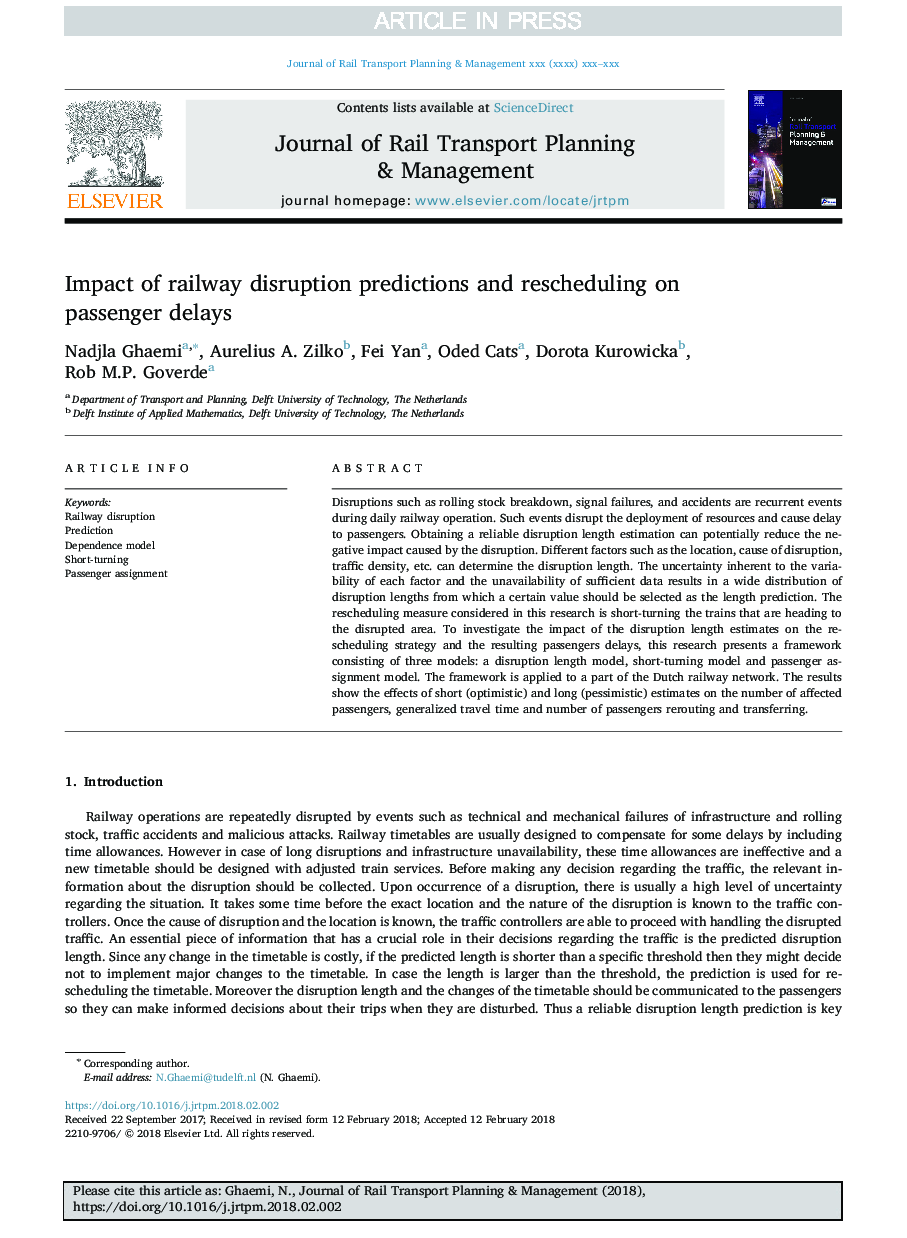| کد مقاله | کد نشریه | سال انتشار | مقاله انگلیسی | نسخه تمام متن |
|---|---|---|---|---|
| 8953497 | 1645937 | 2018 | 20 صفحه PDF | دانلود رایگان |
عنوان انگلیسی مقاله ISI
Impact of railway disruption predictions and rescheduling on passenger delays
ترجمه فارسی عنوان
تأثیر پیش بینی وقوع اختلال در راه آهن و تعویض مجدد در تاخیرهای مسافرتی
دانلود مقاله + سفارش ترجمه
دانلود مقاله ISI انگلیسی
رایگان برای ایرانیان
کلمات کلیدی
اختلال در راه آهن، پیش بینی، مدل وابستگی، کوتاه شدن انتصاب مسافر،
ترجمه چکیده
اختلالاتی مانند فروپاشی سهام نورد، ناهماهنگی سیگنال و حوادث حوادث عادی در طول عملیات راه آهن روزانه است. چنین حوادث ناشی از استقرار منابع و تأخیر به مسافران است. برآورد طول تخمین قابل اعتماد می تواند به طور بالقوه تاثیر منفی ناشی از اختلال را کاهش دهد. عوامل مختلفی چون موقعیت، علت اختلال، تراکم ترافیک و غیره می توانند طول وقفه را تعیین کنند. عدم اطمینان ذاتی متغیر هر عامل و عدم دسترسی کافی داده ها موجب توزیع گسترده ای از طول وقفه می شود که از آن یک مقدار معین باید به عنوان پیش بینی طول انتخاب شود. اندازه گیری زمانبندی در نظر گرفته شده در این تحقیق کوتاه کردن قطارهایی است که به منطقه متلاشی شده اند. برای بررسی تأثیر برآورد طول وقفه بر روی استراتژی بازنشستگی و تاخیرهای ناشی از مسافران، این تحقیق چارچوبی متشکل از سه مدل ارائه می دهد: یک مدل طول اختلال، مدل کوتاه شدن و مدل انتصاب مسافر. این چارچوب به بخشی از شبکه راه آهن هلندی اعمال می شود. نتایج نشان می دهد که اثرات تخمین های کوتاه (خوش بینانه) و طولانی (بدبینانه) بر تعداد مسافران معیوب، زمان سفر عمومی و تعداد مسافرانی که در حال حرکت و انتقال هستند، نشان می دهد.
موضوعات مرتبط
مهندسی و علوم پایه
مهندسی کامپیوتر
نرم افزارهای علوم کامپیوتر
چکیده انگلیسی
Disruptions such as rolling stock breakdown, signal failures, and accidents are recurrent events during daily railway operation. Such events disrupt the deployment of resources and cause delay to passengers. Obtaining a reliable disruption length estimation can potentially reduce the negative impact caused by the disruption. Different factors such as the location, cause of disruption, traffic density, etc. can determine the disruption length. The uncertainty inherent to the variability of each factor and the unavailability of sufficient data results in a wide distribution of disruption lengths from which a certain value should be selected as the length prediction. The rescheduling measure considered in this research is short-turning the trains that are heading to the disrupted area. To investigate the impact of the disruption length estimates on the rescheduling strategy and the resulting passengers delays, this research presents a framework consisting of three models: a disruption length model, short-turning model and passenger assignment model. The framework is applied to a part of the Dutch railway network. The results show the effects of short (optimistic) and long (pessimistic) estimates on the number of affected passengers, generalized travel time and number of passengers rerouting and transferring.
ناشر
Database: Elsevier - ScienceDirect (ساینس دایرکت)
Journal: Journal of Rail Transport Planning & Management - Volume 8, Issue 2, September 2018, Pages 103-122
Journal: Journal of Rail Transport Planning & Management - Volume 8, Issue 2, September 2018, Pages 103-122
نویسندگان
Nadjla Ghaemi, Aurelius A. Zilko, Fei Yan, Oded Cats, Dorota Kurowicka, Rob M.P. Goverde,
